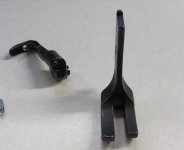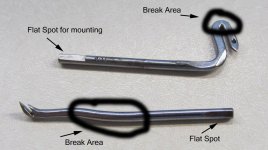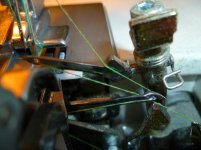Jason H
Stainless
- Joined
- Mar 29, 2006
- Location
- Los Angeles, CA.
Attached are photos of some common sewing machine parts. The two silver items are parts that often break in the middle. The important areas of these parts are the pointed area. I am not sure of the type of metal used, but they are slightly bendable. If one of these breaks, can I tig it back together successfully?
Next items are common feet for sewing machines. The shaft area are what mount to the machine, the bottom is what I am looking to modify / remake. They are hardened all the way through and it is super hard. Not sure of what value since I don't have a tester. I want to change the bottoms to accommodate different types of products. Can I cut the bottom part off and reweld the new design to it? The only part that really wears is what comes in contact with fabric ( bottoms ) Time is always short for me so I dont want to have to make these from scratch. The set of standard feet is about 8 bucks.
I am working of a miller sync 250.
Thanks
Jason
Next items are common feet for sewing machines. The shaft area are what mount to the machine, the bottom is what I am looking to modify / remake. They are hardened all the way through and it is super hard. Not sure of what value since I don't have a tester. I want to change the bottoms to accommodate different types of products. Can I cut the bottom part off and reweld the new design to it? The only part that really wears is what comes in contact with fabric ( bottoms ) Time is always short for me so I dont want to have to make these from scratch. The set of standard feet is about 8 bucks.
I am working of a miller sync 250.
Thanks
Jason








